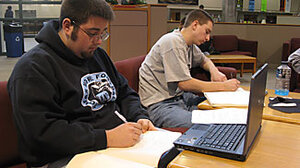Engineering suddenly hot at universities
The recession and a desire to make a difference drive more students toengineering programs. But the US still faces a shortage in the profession.

Jonathan Liegois (l.) is a freshman at the Milwaukee School of Engineering in Wisconsin. Here, he works on an assignment in the school's student center.
Richard Mertens
Milwaukee
Jonathan Liegois once wanted to be a marine biologist. Instead, the college freshman is here at the Milwaukee School of Engineering, his dream of undersea discovery replaced by the more practical ideal of a steady job and good income.
"The job outlook is high," he says, echoing the sentiments of many classmates. "If you stick to it, it will pay off."
Across the United States, enrollment in engineering programs has risen to levels not seen in three decades. The recession appears to be one factor, as students and their parents look for dependable careers.
But some education officials detect a shift in opinion about the profession itself, as global warming and stem-cell research make fields like chemical and bioengineering more than just wise choices for job-seekers – but fashionable ones, too.
Many students are bringing to engineering a heightened sense of social responsibility and a desire "to go out and make a difference in the world," says Joseph Helble, dean of the Thayer School of Engineering at Dartmouth College in Hanover, N.H., where enrollment in introductory undergraduate courses is 30 percent above the five-year average.
Nationally, enrollment in undergraduate engineering programs rose 3 percent in 2007 and 4.5 percent 2008, according to the American Association of Engineering Education. Meanwhile, enrollment in masters' degree programs rose 7 percent in 2007 and 2 percent in 2008. In the fall of 2008, 91,489 masters degree students and 403,193 undergraduates were studying engineering at US universities and colleges.
Skeptics note that engineering remains a low priority for US students: Among the 25 top engineer-producing countries, the United States ranks No. 22 on a per capita basis. But here at the Milwaukee School of Engineering, applications have rebounded 25 percent during the past two years – with enrollment rising from 550 to 732 – after falling early in the decade. At Worcester Polytechnic Institute in Worcester, Mass., applications have risen 70 percent over the past five years, and the 902 freshmen who enrolled last fall were 100 more than expected.
"People laugh when I say we have another record-breaking year," said Kristin Tichenor, vice president of enrollment management at Worcester Polytechnic. "But it keeps going up."
The profession fell in popularity after the mid-1980s and has been struggling to recover ever since. Especially in depressed economic times, the lure of good job prospects for engineers seems to be helping.
"I do think that students, when difficult economic times come around, kind of fall back on some of the main curriculums – the bread-and-butter curriculums," says Tim Valley, vice president of enrollment management at the Milwaukee School. "There's also quite a bit written about the shortage of engineers in the United States: I think students are picking up on that."
For their part, undergraduates here say they were drawn to engineering for many reasons, including traditional ones like a love of math and science. But economic concerns do loom large.
Sophomore Jeremy Heim thought about studying architecture. But engineering seemed to be a safer choice. "The more research I did in architecture, the more I realized it's not very reliable," says Heim of Lansing, Ill.
Others here, however, suggest an evolution in engineering.
Freshman Marguerite Wellstein, who is working with classmates to design a can-opener that can be operated with one hand, says she is studying biomedical engineering because "you get a better sense of helping people."
Her motivation suggests a change from the past. Last year, a National Academy of Engineering report lamented that "the public believes engineers are not as engaged with societal and community concerns as scientists or as likely to play a role in saving lives."
Biomedical advances, including those suggested by stem-cell research, have made biomedical engineering one of the fastest growing disciplines, especially for women. The concern over global warming and energy development has also drawn more young people to chemical and environmental engineering.
"Engineering enrollments peaked in the late '70s and early '80s when there were significant challenges with energy and the environment," says Mr. Helble of Dartmouth. "Fast forward 30 years, and we're in the same situation."
Some engineering schools have gone further, expanding into nontraditional fields to gains students. Three years ago, Worcester Polytechnic started a program in developing computer games and interactive media. "It took off," says Ms. Tichenor says.
There are doubts that the recent rise in enrollments points to a long-term change, however. Noting that America still produces relatively few engineers, the recent increases "are not anything to hang your hat on," says Richard Heckel, founder of Engtrends, a consulting firm in Houghton, Mich. The decline of auto industry could also turn high school students away.
Old problems hamper engineering schools, too: Attrition remains high and schools still struggle to attract larger numbers of blacks, Hispanics, and women.
"Programs that have been able to link with biomedical and environmental engineering, which are growing fields within engineering, they've been more attractive to women," says Daryl Chubin, head of the Center for Advancing Science and Engineering Capacity at the American Association for the Advancement of Science. "In general, however, people interested in the environment and energy are going to think about scientific disciplines, not engineering."
At the Milwaukee School of Engineering, freshman Ms. Wellstein is happy to be an exception. "Engineers have the best outlook," she says. "Most kids coming to MSOE have a job when they leave, even now."
